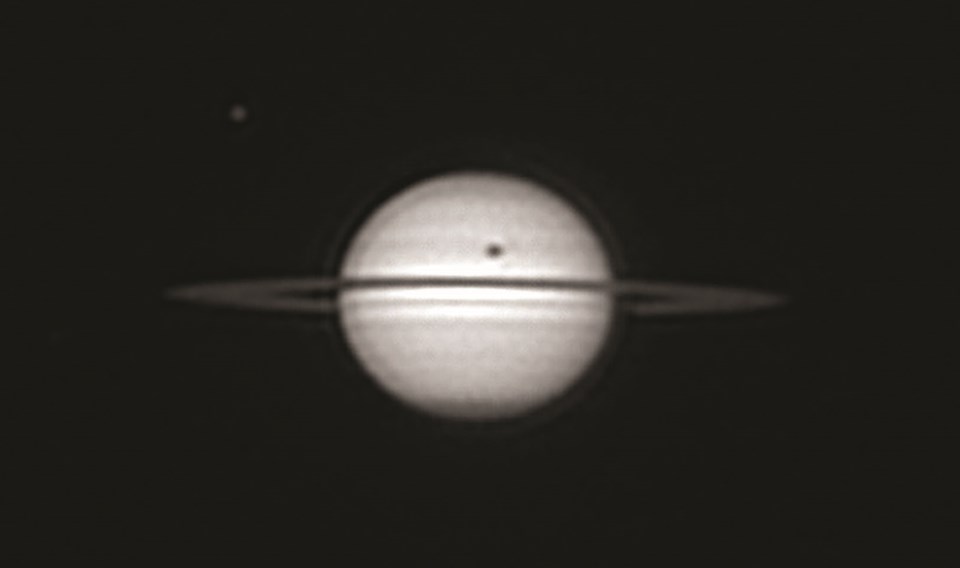At the time of this writing, June 23, Jupiter was about half a degree left of the afternoon Sun and due to pass behind it just after sunset. So, there won’t be anything to see in Jupiter’s neighbourhood until it’s well clear of the Sun; we’ll just have to look for other stuff.
July begins with Venus west of the Sun before sunrise but the ecliptic, where the Sun and planets move, is tilted towards the south in that area and Venus only appears about 5 degrees above the horizon, just north of due east. If you look at about 03:30 July 1 with a clear view to the east, it will look like an aircraft landing light. Although Venus is really bright, it’s pretty boring visually since all you see is clouds; with about 30+ magnification it’s a blob.
Our objective however is not Venus, it’s just our starting point. If you look about twice as high above the horizon as Venus and up to the left, you should see the Pleiades cluster, six or seven naked-eye stars, many more in binoculars. For the first week of July, these two celestial landmarks will be your guide to Uranus.
Now that the juvenile male audience has quit giggling, I will explain; our motion and that of Venus make it appear to move almost horizontally to the left, passing below the Pleiades cluster and on July 4, directly between that cluster and Uranus. About 40 per cent of the distance from Venus to the Pleiades, with binoculars you should be able to see a pale white object just below naked eye visibility. It may have a slight greenish tinge to it and it won’t twinkle like the nearby stars. This is the seventh planet in our solar system, Uranus, named after the Greek god of the sky. According to myth, he was the father of Saturn and the grandfather of Jupiter.
Uranus is something of an anomaly in our solar system; it was the first planet to be discovered with a telescope –– by William Herschel in 1781 –– and confirmed as a planet some time later by Johann Bode who proposed its name as well. Uranus is slightly larger than Neptune, its outer sister planet, but is less massive. It also spins quickly: one day is 17.9 hours long, and its rotational axis is tipped 97 degrees to its orbital plane. Essentially, the entire planet, rings, moons and all is lying over on its side, probably as a result of a collision with another planetoid in the distant past. If you’re good at mental gymnastics, try to imagine what path the Sun would take daily and seasonally if you hovered over one spot on Uranus.
Next, we’ll have a look at Saturn; if you look about twenty degrees to the right of Venus and about twice as high above the horizon, you should be able to see it -another reasonably bright object that’s not twinkly. Saturn just passed its fall equinox so that its 15-year-long southern summer season is beginning. Saturn’s rings and its moons are exactly lined up around its equator, which is tipped 26.7 degrees from its orbital plane around the Sun, so each hemisphere experiences seasons, just as the Earth does.
Because Saturn’s rotational axis stays put, the Sun (and Earth) pass through its equatorial plane twice during each orbit, so about every 15 years or so. When we pass through its equatorial plane, the rings vanish because they’re very thin but another thing happens: when the Sun is in the plane of Titan’s rotation around Saturn, its shadow falls on Saturn’s cloud tops, causing a Saturnian total eclipse of the Sun. From Saturn’s cloud tops, Titan is about 0.23 degrees wide while the Sun is only 0.06 degrees wide. Titan’s big, by the way, slightly smaller than Ganymede and over 50 per cent bigger than our Moon. It’s even slightly bigger than Mercury.
On June 16, Robert Lunsford of El Cajon, California, photographed one of these eclipse events: “This photo was captured in infrared light to enhance the sharpness,” Lunsford says. The black shadow on Saturn is Titan’s. Granted, this sort of imaging is beyond most people’s capabilities but it’s neat to see.
As in June, Neptune is lurking just above Saturn and is just visible in binoculars, although a tripod support for the binocs is recommended. Since June, Saturn has moved slowly left so that Neptune is just about one degree away from Saturn at the 11 o’clock position. About one and a half times that distance above Saturn and slightly right should be another star a little brighter than Neptune. See those three and you’ve found Neptune! The best way to estimate angles through binoculars is to check the field of view that’s usually engraved on the eyepiece of the main body. Take a look at the Moon through yours and remember that the Moon is 0.5 degrees wide, same as the Sun.
The monthly meetings of the Astronomy Club are paused until September but check the club website and Facebook for observatory openings and other stellar events. Check on T Corona Borealis and many other events at spaceweather.com.



